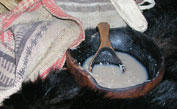Study Guide Household

Table of Contents
Food
 When the Puritans prepared to immigrate to New England, they were careful not only to bring along not only clothes, plows, and tools, but also “meale for bread, [and] malt for drink” (Dow 3). One pastor suggested in 1630 the following food stuffs for potential settlers: “8 Bushels of meale, 2 Bushels of pease, 2 Bushels of Otemeale, 1 Gallon of Aquavitae, 1 Gallon of Oyle, 2 Gallons of Vinegard, 1 Firkin of Butter; also Cheese, Bacon, Sugar, Pepper, Cloves, Mace, Cinnamon, Nutmegs, and Fruit” (Dow 3; quotes Rev. Francis Higginson, New-England’s Plantation. London, 1630). Salt beef, biscuits, and salt fish were also popular sea fare (Dow 5, 7). Once colonists arrived they began to farm, fish, and raise livestock. The inventories of estates in Massachusetts Bay Colony mention a variety of forms of local fish, locally raised meat, and local fruits, vegetables and grains (Dow 42). These included
When the Puritans prepared to immigrate to New England, they were careful not only to bring along not only clothes, plows, and tools, but also “meale for bread, [and] malt for drink” (Dow 3). One pastor suggested in 1630 the following food stuffs for potential settlers: “8 Bushels of meale, 2 Bushels of pease, 2 Bushels of Otemeale, 1 Gallon of Aquavitae, 1 Gallon of Oyle, 2 Gallons of Vinegard, 1 Firkin of Butter; also Cheese, Bacon, Sugar, Pepper, Cloves, Mace, Cinnamon, Nutmegs, and Fruit” (Dow 3; quotes Rev. Francis Higginson, New-England’s Plantation. London, 1630). Salt beef, biscuits, and salt fish were also popular sea fare (Dow 5, 7). Once colonists arrived they began to farm, fish, and raise livestock. The inventories of estates in Massachusetts Bay Colony mention a variety of forms of local fish, locally raised meat, and local fruits, vegetables and grains (Dow 42). These included
Bacon, beef, butter, cheese, eggs, fowls, lamb, milk, mutton, pork, suet, veal, wild game, and cod, herring mackerel, salmon, and sturgeon. Barley, beans, Indian beans, bran, cabbages, carrots, chaff, corn, English corn, hops, Indian meal, rye meal, oatmeal, oats, parsnips, peas, pumpions, rye, squashes, turnips, and wheat. Apples, berries, fruit, honey, raisins, sugar, and vinegar. Biscuit, blewlman, bread, cake, malt, salad oil, porridge, rye, malt, yeast, salt, and many kinds of spices (Dow 42).
From early on Puritans adapted their diet to the New England landscape and vice versa. Cod and Alewife ("herring") were two of the most important fish for colonists.
 Wampanoag diets underwent a similar transformation in the seventeenth and eighteenth centuries. As David Silverman notes, during the eighteenth-century “the intersection of changes in native economy and Indian tastes in food and clothing, with the debilitating effects of disease, meant that natives generally became dependent upon store credit for clothing and sustenance” (Silverman 322). Account books such as the one by Chilmark merchant John Allen provide evidence of what sorts of goods Wampanoags on the island produced, sold, and bought during the colonial era. Purchases included beans, corn, peas, barley, rye, flour, fish, beef, mutton, pork, coffee, tea, hone (a sweetener), molasses, sugar, fruit, starches, biscuits, and cheese (Silverman 327). Charges for food, particularly corm, meat, and sweeteners, ran as much as 25% of the total native purchases at island stores in the eighteenth century (Silverman 326-27). Allen’s account book also displays the island practice of leasing “on the halves”: that is, when Wampanoags raised livestock on Wampanoag lands for colonists like Allen, they were allowed to claim either half of the offspring or half their value (Silverman). Animal husbandry was one way other than indenturement that Wampanoags paid off the debts incurred at white stores (Silverman).
Wampanoag diets underwent a similar transformation in the seventeenth and eighteenth centuries. As David Silverman notes, during the eighteenth-century “the intersection of changes in native economy and Indian tastes in food and clothing, with the debilitating effects of disease, meant that natives generally became dependent upon store credit for clothing and sustenance” (Silverman 322). Account books such as the one by Chilmark merchant John Allen provide evidence of what sorts of goods Wampanoags on the island produced, sold, and bought during the colonial era. Purchases included beans, corn, peas, barley, rye, flour, fish, beef, mutton, pork, coffee, tea, hone (a sweetener), molasses, sugar, fruit, starches, biscuits, and cheese (Silverman 327). Charges for food, particularly corm, meat, and sweeteners, ran as much as 25% of the total native purchases at island stores in the eighteenth century (Silverman 326-27). Allen’s account book also displays the island practice of leasing “on the halves”: that is, when Wampanoags raised livestock on Wampanoag lands for colonists like Allen, they were allowed to claim either half of the offspring or half their value (Silverman). Animal husbandry was one way other than indenturement that Wampanoags paid off the debts incurred at white stores (Silverman).
Items Related to Food in the Archive
Material Possessions < Previous | Next > Clothing